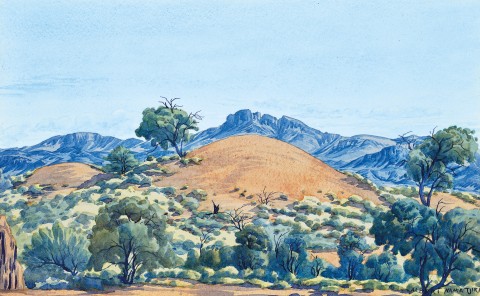SAND HILL BOUNDARY, c.1950s
ALBERT NAMATJIRA
watercolour on paper on card
32.0 x 52.0 cm
signed lower right: ALBERT NAMATJIRA
bears inscription verso: 1
bears inscription with title on backing verso: SAND HILL BOUNDARY CB 80
Frank S. & Winifred M. Wright, Melbourne, acquired c.1950s
Thence by descent
Winifred B. Calder, Melbourne, acquired from the above in the 1980s
The Estate of W. B. Calder, Melbourne
Although an accomplished craftsman producing poker work decorated woomeras, boomerangs and wooden plaques, it was not until viewing an exhibition of watercolours by Victorian artists Rex Battarbee and John Gardner at the Hermannsburg Mission in 1934, that Albert Namatjira truly embarked upon painting as a profession. Immediately captivated by the medium, Namatjira pleaded to be taught watercolour techniques and eventually Battarbee agreed to Namatjira accompanying him on two month-long expeditions in 1936 through the Palm Valley and MacDonnell Range areas. And thus began the cultural exchange that was to become a defining feature of their long relationship; Battarbee instructing Namatjira about the Western technique of watercolour painting, and in turn, Namatjira imparting his sacred knowledge about the subjects they were to paint, namely the land of the Western Aranda people, his ‘Dreaming’ place. So impressive was Namatjira’s skill that Battarbee remarked after only a brief period, ‘I felt he had done so well that he had no more to learn from me about colour.’1 Success and recognition quickly followed and Namatjira was launched into the spotlight as a cultural ‘icon’ – internationally acclaimed and admired for his innovative, vibrantly coloured desert landscapes that encouraged ‘new ways of seeing the Centre.’
If today synonymous with our vision of the Australian outback, Namatjira’s art nevertheless experienced many vicissitudes over the course of the last century. Although his first solo exhibition in 1938 at the Fine Arts Society in Melbourne was a sell-out success, with popularity and fame continuing throughout his lifetime, praise for Namatjira’s skilful adaptation of a Western medium was inevitably accompanied by a bitter twist; his paintings ‘…were appreciated because of their aesthetic appeal, but they were at the same time a curiosity and sign that Aborigines could be civilised.’2 Ironically such perceived ‘assimilation’ would later bring his art into disrepute with Namatjira virtually ignored by the Australian art establishment during the 1960s and 70s. Fortunately, the Papunya Tula Aboriginal art ‘renaissance’ and cultural politics of reconciliation during the 80s prompted long overdue reassessment of Namatjira’s unique contribution, and more recently, he has received the recognition he so deserves with three biographies published, and three major exhibitions mounted by public galleries, including a retrospective at the National Gallery of Australia in 2002 to celebrate the centenary of his birth, Seeing the Centre: The Art of Albert Namatjira 1902 – 1959.
Not only striking in their aesthetic appeal, Namatjira’s achievements such as Sand Hill Boundary, c.1950s also resonate with important personal symbolism for the artist as statements of belonging – as coded expressions embodying the memory and sacred knowledge of traditional ancestral sites, his ‘dreamings’ or totem places. As Belinda Croft elucidates, ‘Albert’s Gift’ was more far-reaching than simply the tangible legacy of his art, ‘…more than the sum parts of watercolour paints on paper. It is an essence that resides in the strength of Namatjira’s work – his courage, his sorrow, his spirituality – in these days of ‘reconciliation’, but most of all, in the spiritual heritage of every indigenous person in Australia.’3
1. Morphy, H., Aboriginal Art, Phaidon Press, London, 1998, p. 268
2. Ibid., p. 270
3. Croft, B., ‘Albert’s Gift’ in French, A., Seeing the Centre: The Art of Albert Namatjira, 1902 – 1959, National Gallery of Australia, Canberra, 2002, p. 148
VERONICA ANGELATOS
